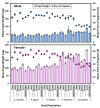Comparison of Survival and Development of Gypsy Moth Lymantria dispar L. (Lepidoptera: Erebidae) Populations from Different Geographic Areas on North American Conifers
- PMID: 32344583
- PMCID: PMC7240718
- DOI: 10.3390/insects11040260
Comparison of Survival and Development of Gypsy Moth Lymantria dispar L. (Lepidoptera: Erebidae) Populations from Different Geographic Areas on North American Conifers
Abstract
Host utilization information is critical to managers for estimating the hosts at risk and potential geographic range for gypsy moths from different geographic origins. In this study, the development and survival of gypsy moths from all three subspecies on 13 North American conifers and three broadleaf hosts were compared. There was variation in the ability of gypsy moth larvae from different geographic origins to utilize (survive and develop on) key North American conifers. However, that variation was not consistent within gypsy moth subspecies, but instead was more consistent with populations from different origins being preadapted to utilize different hosts and having different biologic traits. Some Asian populations developed and survived well on some conifers while populations from Europe and North America gained weight faster and/or survived better than some Asian populations. Although development was slower and survival poorer on several of the conifers, first instar larvae were able to utilize conifers unless the needles were tough or feeding deterrents were present. Host phenology was also critical since the early instars fed preferentially on new foliage or buds. Gypsy moth larvae can utilize many hosts, so this makes it a very adaptable invasive species that warrants taking measures to prevent its spread.
Keywords: Lymantria dispar; conifers; development; gypsy moth; host utilization; survival.
Conflict of interest statement
The authors declare no conflict of interest.
Figures



References
-
- Endara M.J., Coley P.D., Ghabash G., Nicholls J.A., Dexter K.G., Donoso D.A., Stone G.N., Pennington R.T., Kursar T.A. Coevolutionary arms race versus host defense chase in a tropical herbivore-plant system. Proc. Natl. Acad. Sci. USA. 2017;114:E7499–E7505. doi: 10.1073/pnas.1707727114. - DOI - PMC - PubMed
-
- Seebacher F., White C.R., Franklin C.E. Physiological plasticity increases resilience of ectothermic animals to climate change. Nat. Clim. Chang. 2015;5:61–66. doi: 10.1038/nclimate2457. - DOI
-
- Matsuki M., Kay N., Serin J., Scott J.K. Variation in the ability of larvae of phytophagous insects to develop on evolutionarily unfamiliar plants: A study with gypsy moth Lymantria dispar and Eucalyptus. Agric. For. Entomol. 2011;13:1–13. doi: 10.1111/j.1461-9563.2010.00492.x. - DOI
-
- Lechowicz M.J., Mauffette Y. Host preference of the gypsy moth in eastern North America versus European forests. Rev. D Entomol. Du Que. 1986;31:43–51.
Grants and funding
LinkOut - more resources
Full Text Sources

